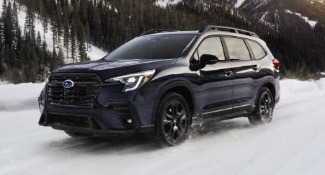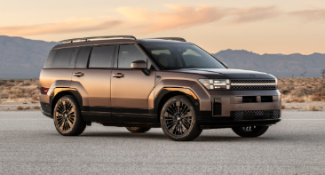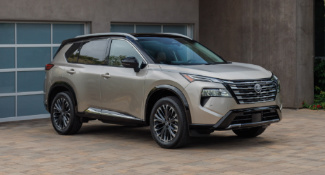Vehicle Type: The 2024 Subaru Ascent is a three-row midsize crossover SUV with seven or eight-passenger seating, depending on the trim level.
Price Range: Base model Subaru Ascent models come with a starting MSRP of $35,740 after the destination fee is added. Top-end Ascent Touring models start at $49,790 and can rise to over $54,000 with multiple accessories equipped.
Powertrain: There is only one powertrain available across the entire Ascent lineup.
Each model is powered by a turbocharged flat-four engine that produces 260 horsepower and 277 lb-ft of torque.
Subaru’s full-time Symmetrical All-Wheel-Drive system and a continuously variable automatic transmission also come standard.
What’s New for 2024?
Subaru gave the Ascent an extensive mid-cycle refresh for the 2023 model year, updating its exterior styling, giving it standard Apple CarPlay and Android Auto, and providing each model with a new 11.6-inch touchscreen as standard. Because of that, the Ascent does not see any major changes for the 2024 model year.
What’s Good?
- Subaru’s focus on driver and passenger safety means that the Ascent is loaded with standard driver assistance features and earns top-notch safety ratings on top of that
- A compliant suspension helps passengers get where they are going in comfort
- All-wheel-drive is standard across the entire lineup
What’s Bad?
- The engine and CVT combination can make the Ascent feel like it lacks power and refinement when pushed
- The Ascent’s third row is on the tight side, even for the typically cramped midsize segment
- Several competitors offer a more refined and upscale interior feel
Would we buy one? Probably Not. The midsize crossover segment is a packed one, and with excellent competition from the likes of the Kia Telluride, Hyundai Palisade, and Honda Pilot, it is hard for us to be convinced that the Ascent is better.
More Photos:
See more 2024 Subaru Ascent Photos.
Overview:

Subaru introduced the Ascent to the world for the 2019 model year as a continuation of its lineup of smaller vehicles. A focus on safety and utility has helped the Ascent fit right in with existing models like the Forester, Outback, and Crosstrek. Additionally, the Ascent’s standard all-wheel-drive system helps it stand out in a packed segment of three-row SUVs, the majority of which come standard with front-wheel drive.
The Ascent competes against other three-row crossovers like the Kia Telluride, Honda Pilot, Ford Explorer, Hyundai Palisade, Toyota Highlander, Chevrolet Traverse, Mazda CX-90, Nissan Pathfinder, and Volkswagen Atlas.
It is not as large as the Honda Pilot, Kia Telluride, or Hyundai Palisade, all of which feature more passenger and cargo space. It is also not as capable off-road as the four-wheel drive, two-row Toyota 4Runner. Still, the Ascent has enough space to make most small families happy, and it comes with more capability than most standard three-row crossovers.
Its attractive starting price and high safety scores make it an especially good choice for those who need a family hauler but also do not want a minivan. Despite not having the most posh interior in the segment, its straightforward cabin layout is a breath of fresh air for those who like simplicity.
Overall Score: 3.5/5 stars
Driving Experience: 2/5 stars

The Subaru Ascent’s smooth ride, courtesy of its comfortable seats and compliant suspension, is one of the best aspects of its driving experience. It falls well short of the best-in-class in many other aspects. Its 260-horsepower engine is enough to shuffle its 4,500-pound curb weight around town, but the CVT does not like to be pushed.
It makes the engine feel taxed when passing or hard accelerating power is required, and the sound-deadening in the cabin is not as apparent as in other models. Acceleration from a standstill is equally as uninspiring though hard braking offers back a bit more driver confidence.
Most three-row midsize crossovers are meant to be minivan alternatives, and none of them are as engaging to drive as a sportier coupe or even a family sedan with a lower center of gravity. The Mazda CX-90 wins the driving experience contest since, in typical Mazda fashion, it outhandles all of its competitors with a smile. The Ascent is not terrible around the corners, but there will likely be nobody excited to take it up a mountain pass on a Sunday afternoon at full speed.
The lack of Wilderness trim as is offered on Forester and Outback models means that any real off-road potential is held back, but most buyers will not be too keen to use their Ascent’s for much more than winter weather conditions anyway.
Safety Features: 4.5/5 stars

One big thing the Ascent has going for it is its stellar safety scores. The NHTSA has given the 2024 Subaru Ascent a perfect five-star overall safety rating. The Insurance Institute for Highway Safety has followed that up with a perfect score of its own. The Ascent has even earned IIHS’ highest honor of a Top Safety Pick+ award.
Each Ascent model comes with Subaru EyeSight, Subaru’s suite of driver assistance technology that utilizes a camera system to monitor its surroundings as you drive. It includes features like adaptive cruise control, lane-departure warning, lane-keeping assist, pre-collision braking, pedestrian detection, and pre-collision throttle management. In addition to those features, each Ascent comes with adaptive headlights, a rear-seat alert system, and automatic high-beam headlights.
Blind-spot monitoring and rear-cross traffic alert are standard on the second-lowest Premium trim level. Other safety features like driver attention monitoring, rain-sensing windshield wipers, reverse automatic emergency braking, and a surround-view camera system become available as you climb the trim level ladder.
The Ascent narrowly misses a perfect safety score from us since both the Kia Telluride and Hyundai Palisade are also Top Safety Pick+ award-winners with rear cross-traffic alert and blind-spot monitoring as standard equipment.
Value: 4/5 stars

With a starting price of under $36,000 and standard all-wheel drive, the Ascent sets itself up well in the value department. It is currently the least expensive three-row all-wheel drive crossover on the market. Less expensive mid-size competitors only offer two-row seating while even the Kia Telluride and Hyundai Palisade carry higher starting MSRPs with front-wheel drive as standard.
That being said, the Ascent is on the smaller side of the midsize crossover spectrum. Limited third-row legroom and 75.4 cubic feet of total cargo space behind the front row of seats fall behind its toughest competitors. Additionally, other competitors feature more upscale interiors with their higher starting price tags.
We still give the Ascent a high value rating. Subarus tend to hold their values well, and the Ascent has been historically proven to do the same. Subaru fans tend to be loyal to their automaker, giving the Ascent an even stronger value score. Still, the Honda Pilot, Kia Telluride, and Hyundai Palisade once again win the value war by offering better overall packaging, despite each one’s higher MSRP.
Tech Features: 3.5/5 stars

In addition to its robust suite of driver assistance features, the 2024 Ascent offers a wide variety of tech features to keep passengers happy. An 11.6-inch touchscreen, wireless Apple CarPlay, wireless Android Auto, and a user-friendly infotainment system all highlight its tech offerings. Tri-zone automatic climate control, Bluetooth, first and second-row USB ports, a six-speaker audio system, and Subaru’s X-Mode drive system all appear on base models.
Ambient interior lighting, a 14-speaker Harman Kardon audio system, an auto-dimming rearview mirror, a heated steering wheel, a panoramic moonroof, heated second-row seats, ventilated front seats, and a power-operated liftgate become available for more cash as buyers climb the available trim levels.
The Ascent’s large touchscreen and wireless smartphone connectivity are excellent features at its price point and outshine several key competitors. A few competitors offer larger touchscreens and other amenities like wireless device charging and large digital driver information screens. It lacks some of the higher-end features that competitors feature, but its overall tech list is solid and offers most of what buyers want.
Practicality: 3.5/5 stars

The Subaru Ascent falls to the high end of the middle of the pack when it comes to practicality. It has three rows of seats which add to its allure. The third-row seat is small, though, with only 31.7 inches of legroom. The second row is more generous with 38.6 inches of legroom. The front row is spacious enough for just about anyone. Headroom is also generous across all three rows, but with the third row being so tight, most rear seat occupants will have little issue there.
17.8 cubic feet of cargo space is available behind the rear seats. When they are folded, 43.5 cubic feet open up behind the second row. 75.6 cubic feet are available behind the front row, but models equipped with the panoramic moonroof will find a touch less. 19 cupholders are scattered throughout the cabin for any liquid cargo you and your family may be carrying.
All Ascent models can tow up to 5,000 pounds which is average for the class. Models like the Chevrolet Traverse, Honda Pilot, and Kia Telluride offer more cargo space and overall legroom than the Ascent. On the other hand, models like the Hyundai Santa Fe, Honda Passport, and Chevrolet Blazer offer more on the cargo front than the passenger front with only two rows of seats.
Styling & Design: 3.5/5 stars

The Ascent’s styling is undoubtedly Subaru-esque. It almost looks like a larger Forester. That being said, its styling is not overdone as with many modern rivals, and it does not try too hard to be different. Its grille is large and perhaps a little odd, but it is proportional to the crossover’s size. Overall, the Ascent offers pleasing and proportional exterior styling that most should find attractive.
The inside of the Ascent is well-built but a bit bland. That is not a bad thing, especially for typical Subaru buyers who do not want or need a thrilling, modern dashboard full of screens and lights. Models with ambient lighting and Nappa Leather add a nice touch to everything, but even those features do not elevate the Ascent’s overall feel to the best in class.
The Honda Pilot and Mazda CX-90 are the Ascent’s top two competitors here. Both have arguably better exterior styling and both win the interior styling batter easily over their Japanese rival.
Fuel Efficiency: 3.5/5 stars

For being a vehicle with full-time all-wheel-drive, the Ascent gets good fuel economy compared to several other crossovers in the class with all-wheel-drive. Several front-wheel-drive models across the segment earn higher overall averages than the Ascent, but many AWD models fall behind it.
The EPA rates base and Premium models at 20 MPG in the city and 26 MPG on the highway. The rest of the lineup sees fuel economy numbers drop to 19 MPG in the city and 25 MPG on the highway. The most fuel-efficient AWD Toyota Highlander models beat those numbers handily while the Honda Pilot, Kia Telluride, Ford Explorer, and Hyundai Palisade fall behind. Both the Volkswagen Atlas and Nissan Pathfinder offer similar fuel economy numbers.
With more and more hybrid and plug-in hybrid models popping up every year, there are even more fuel-efficient models that compete in the midsize SUV segment. Subaru does not currently offer the Ascent with any kind of hybrid powertrain, but automakers like Kia, Hyundai, Ford, and Toyota are beginning to offer models that can earn fuel economy estimates of well over 30 MPG.
What’s it Going to Cost Me?

Subaru offers the Ascent in six different trim levels. Each one of them comes with a 260-horsepower four-cylinder turbo engine, a CVT, and all-wheel-drive. Each also comes equipped with adaptive cruise control, lane-departure warning, lane-keeping assist, pre-collision braking, pedestrian detection, pre-collision throttle management, adaptive headlights, a rear-seat alert system, and automatic high-beam headlights.
The base model Subaru Ascent starts at $35,740. It includes an 11.6-inch touchscreen, wireless Apple CarPlay, wireless Android Auto, Bluetooth, tri-zone automatic climate control, a six-speaker audio system, eight-passenger seating with a second-row bench seat, 18-inch alloy wheels, active torque vectoring, Subaru’s X-Mode driving mode, and hill descent control.
A plethora of accessories and upgrades are available to purchase to make your Ascent one-of-a-kind. Some options include a $174.98 second-row sunshades, $447 fog lights, a $2,799.95 Thule roof tent, and an $849.95 Thule roof-mounted awning.
Stepping up to the Subaru Ascent Premium will cost you $38,090 after the destination fee is added. All of the standard features from the base model are carried over to the Premium trim, including the second-row bench seat. Heated front seats, a power-operated driver’s seat, a leather-wrapped steering wheel, a Wi-Fi hotspot, blind-spot monitoring, and rear cross-traffic alert are added.
Second-row captain’s chairs can be added to the Premium trim for an additional $1,460, but that cost is more for the power liftgate, auto-dimming rearview mirror, push-button start, and reverse automatic emergency braking that come with the mandatory Convenience package than the seats themselves. Buyers can choose to add the Convenience package without getting the captain’s chairs if they still require eight-passenger seating.
The Subaru Ascent Onyx Edition is the next model on the trim level pyramid. It starts at $43,140 and includes 20-inch alloy wheels with a black finish, black exterior trim pieces and grille, second-row captain’s chairs, a power liftgate, a panoramic moonroof, a heated steering wheel, an auto-dimming rearview mirror, and an upgraded version of Subaru’s X-mode with additional drive modes.
Just above the Onyx Edition on the food chain the Subaru Ascent Limited, starting at $43,190. This model drops the special black trim from the Onyx Edition and adds leather upholstery, a power-operated passenger seat, a power-operated driver’s seat with memory functionality, heated front and second-row seats, 20-inch alloy wheels, and driver attention monitoring.
Buyers can opt for either a second-row bench seat or captain’s chairs at no additional cost. What will cost extra is the $3,550 Technology package. It includes a surround-view camera, navigation, a panoramic moonroof, a 14-speaker Harman Kardon audio system, and rear cargo cover.
The Subaru Ascent Onyx Edition Limited starts at $48,140, and it includes all of the standard features from the Onyx Edition, all of the standard features from the Limited trim, and the features that would come with the Technology package from the Limited trim. Second-row captain’s chairs are standard.
The top-of-the-line Subaru Ascent Touring starts at $49,790 after the destination fee is added. It mimics the features from the Limited trim but adds Nappa Leather upholstery, ventilated front seats, rain-sensing windshield wipers, ambient interior lighting, second-row captain’s chairs, and the features included in the Technology package.
We are partial to the Subaru Ascent Onyx Edition trim since it adds enhanced drive modes, it comes with some additional safety features, and it has some cool trim pieces. It is not too expensive, and we do not really need the leather seating that comes on higher-end models.


